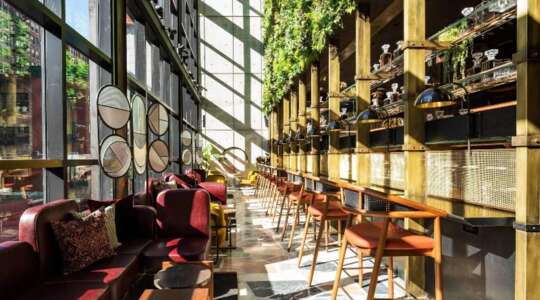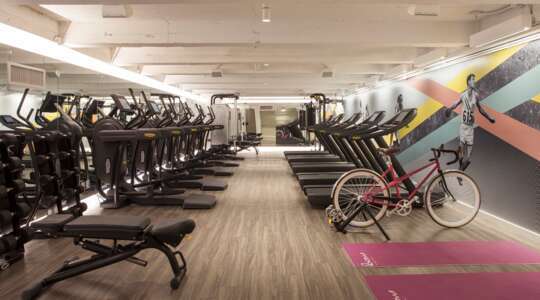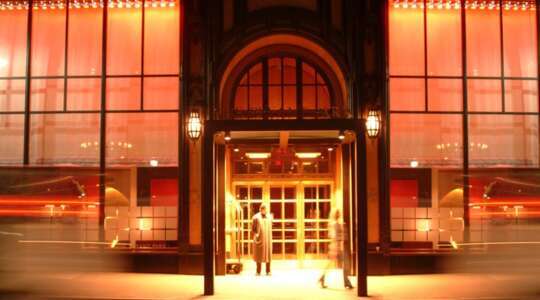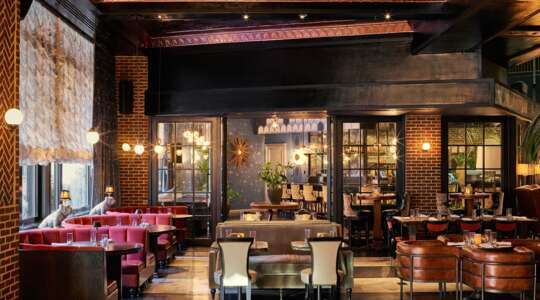Speak to one of our experts now about this offer
Call our North America experts on01306 744 988
Available until 5pm
Crowne Plaza Times Square
Where the front door literally opens onto Times Square
On the face of it this is not an especially exciting hotel, but boasting an esteemed Broadway address as it does, you cannot be any more central in New York than here.
If you’re in town to catch a Broadway show or two, you can’t get a more convenient location than the Crowne Plaza Times Square. Towering over Broadway, it commands one of the most sought-after addresses in the city. Often considered the epicentre of New York, emblematic yellow cabs crawl, camera-toting tourists amble, and enormous advertising screens shroud the skyscrapers. With 795 guestrooms, the Crowne Plaza Times Square is a hotel of mega proportions and a slick operation of good hospitality. In the evening, when the Broadway lights are at their brightest, head to the Broadway 49 Bar and Lounge for cocktails. It won’t be long before the city tempts you to head back out to join the party…
Why we love Crowne Plaza Times Square
-
Even if it's your first time in New York, your locale will seem so familiar with so many of the city's iconic sights on your doorstep
-
The rooms are modern and equipped with flat-screen televisions and aromatherapy amenity kits
-
Opt for a window seat for cocktails at Broadway 49 and you'll be mesmerised by the bright lights of theatreland outside
-
To get a full perspective of New York, it's worth upgrading to a room with a city view
Facilities
Pick up a freshly roasted coffee and bakery items at Grind'n Co Coffee before sightseeing. As well as a range of dishes, Broadway 49 has an extensive beer, wine and cocktail list - ideal for pre or post theatre visits.
Grind'n Co Coffee
Start your day with a coffee from a local New York roastery and grab some items to take with you to keep you replenished as you explore the city.
Broadway 49
Located on the first floor, the restaurant is open for evening dinner from 5pm.
Located in the heart of Times Square, you have pretty much every type of cuisine on your doorstep from fast-food outlets to fine dining.
This hotel is all about location, location, location. Step out onto Times Square, shop on Fifth Avenue, go for a jog in Central Park or take in the views from the Empire State Building. There are over 50 theatres within five blocks of the hotel, but make sure you have pre-booked in advance if you want to catch one of the world-famous shows.
The hotel is part of the IHG Green Engage system - a way for the hotel group to monitor and measure its impact on the environment through its online environmental sustainability system.
Locally Paid Fees & Taxes: Expect to pay approximately $38 per room per night for hotel resort fees and local taxes.
All Hotels in New York

- New York
- 4 Star
A trendy hotel located in the hip and artistic East Village.

- New York
- 4.5 Star
This is urban New York and a perfect location for first-time visitors to easily reach all the must-see attractions.

- New York
- 5 Star
Quite simply, 1 Hotel Brooklyn Bridge is one of the best places in New York to admire the entire Manhattan skyline, and the fact you can do it from its rooftop pool makes it an extra memorable experience.

- New York
- 3 Star
In town to catch a performance at the legendary Apollo Theatre? Aloft Harlem places you almost next door. But there’s so much more in the area besides. Soak up the Harlem atmosphere, feast on soul food, and shimmy from jazz club to jazz club.

- New York
- 4 Star
Aloft Manhattan Downtown – Financial District exudes a confident New York vibe.

- New York
- 3 Star
Ready to find out what all the Brooklyn buzz is about? Nestle yourself in the heart of the borough, Downtown Brooklyn, and use it as a springboard to your adventures.

- New York
- 4 Star
Torn between staying in TriBeCa, West Village, or SoHo? Then consider Arlo SoHo. This buzzy bolthole positions you right at the confluence of these neighbourhoods.

- New York
- 3 Star
If you’re planning to linger longer in NYC or travelling with kids, having a kitchen could be precisely what you need. And you don’t have to give up a super central location for the extra space either. Winner.

- New York
- 4 Star
If a central location trumps everything, you can’t go wrong with DoubleTree by Hilton New York Times Square West.

- New York
- 5 Star
There’s nothing remotely average about Equinox Hotel New York. Everything is either different or better. And its location in the sensational Hudson Yards, right next door to The Edge, couldn’t be more fitting.

- New York
- 4 Star
Listen up, gym bunnies – this is the New York pad for you. With a laser focus on health and wellness, EVEN Hotel New York has gym equipment in-room to keep up your routine when you’re away from home.

- New York
- 4.5 Star
Base your NYC trip in the Financial District (FiDi, if you please), and you’re a short walk away from Battery Park, South Street Seaport, and departures to Ellis Island to visit Lady Liberty herself.

- New York
- 3.5 Star
This all-suite hotel has the convenience of a kitchen in every room.

- New York
- 4 Star
Rub shoulders with the downtown crowd at Hotel 50 Bowery in a once non-descript part of Lower Manhattan bordering Chinatown. This bolthole has an edginess, but it’s the top floor restaurant that’s Hotel 50 Bowery’s crowning glory.

- New York
- 4 Star
Ink 48 promises modern amenities in New York's trendy area of Hell's Kitchen.

- New York
- 4.5 Star
The Lotte is prestigious, historic, and utterly charming.

- New York
- 4 Star
Cosy bedrooms in designer digs, the Moxy NYC Chelsea is the ultimate blend of a central Midtown location in an under-the-radar spot in the Flower District.

- New York
- 4 Star
Moxy NYC Times Square has earned itself plaudits as one of the city’s buzziest locales. But not at the expense of location, location, location.

- New York
- 4 Star
If you hadn’t heard, the Lower East Side is the place to be. And the address on everyone’s lips is Chrystie Street – home of the flamboyant, yet sophisticated, Public.

- New York
- 3 Star
Fun-loving Staypineapple goes to prove that a hotel doesn’t need to be high-end luxury to have oodles of personality.

- New York
- 4 Star
Full marks for location – The Bryant Park Hotel stands proudly over one of Manhattan’s best-loved parks, known for its roster of whimsical activities, people-watching opportunities, and general hustle-bustle.

- New York
- 5 Star
The Chatwal evokes the New York of yesteryear that was all sophistication and elegance.

- New York
- 4 Star
The New Yorker is an instantly recognisable city landmark. The iconic red lettering that adorns the top of this 43-story Art Deco skyscraper is immortalised in movies and can be spotted throughout the city.

- New York
The Roxy isn’t precious. It’s a place that’s at ease being a cataclysmic collision of cultures, eras, and styles. It is what gives it its inimitable personality. From its mid-century-meets-Art-Deco-meets-Regency styling to places to watch unusual foreign films, drink mind-blowing cocktails, and shuck oysters. At the Roxy, anything goes.

- New York
- 5 Star
All hail, The William Vale - an architectural marvel that towers over the neighbourhood, staking its claim as the epicentre of Williamsburg.

- New York
- 3.5 Star
Dip a toe into the prestige of the Upper East Side without splurging on the mega-luxury this illustrious neighbourhood is known for. Think quieter streets, couture shopping, high-end art galleries, and Museum Mile. This is NYC done right.
Sorry, your hotel is no longer available
Please check alternatives
-
{{item.body}}
-
{{item.body}}
Choose a departure date
{{store.searchDuration}} nights
Enter rooms & guests
Checking prices & availability

{{term}}, {{formattedDate}} for {{searchDuration}} nights

_w=24_h=25.png?v=910f6de5506872363a0d58b9f40775d869aae637)
_w=24_h=25.png?v=910f6de5506872363a0d58b9f40775d869aae637)
_w=24_h=25.png?v=910f6de5506872363a0d58b9f40775d869aae637)